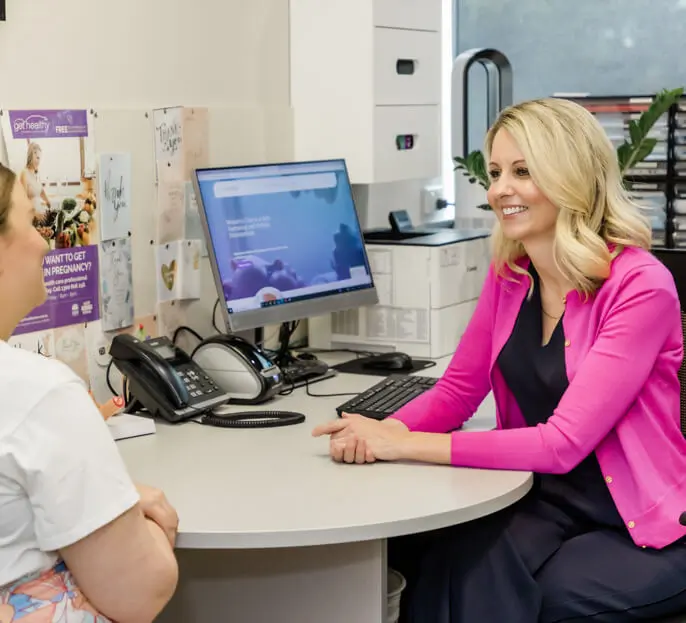Is It Time for a Cervical Screening Test? Women’s Health Screening Explained
When was your last cervical screening test? If you’re unsure, you’re not alone. Many women put off routine gynaecological care, but regular Pap smears, or more accurately, cervical screening tests, are one of the most important tools we have for detecting early changes that could lead to cervical cancer.
At her Gosford clinic, Dr Kelly Hankins, a trusted female gynaecologist and obstetrician, is committed to making screening simple, respectful, and informative. In this article, we’ll explain when you need a cervical screening test, what it involves, and how it helps protect your long-term health.

Pap Smear or Cervical Screening Test?
In 2017, Australia replaced the traditional Pap smear with the Cervical Screening Test (CST). While many still refer to it as a “Pap smear,” the CST is a more advanced test that detects the presence of high-risk Human Papillomavirus (HPV), the virus responsible for nearly all cervical cancers.
Key Differences:
- The CST is required every 5 years, rather than every 2 years (for most women).
- It is more accurate at identifying women at risk of cervical cancer.
- It starts from age 25, and continues until age 74.
Who Needs a Cervical Screening Test?
You should book a CST if:
- You are aged 25 to 74, have a cervix, and have ever been sexually active.
- It has been 5 years or more since your last test.
- You’ve never had a screening and are aged over 25.
- You have new symptoms such as abnormal bleeding, pain, or discharge.
Even if you’ve had the HPV vaccine, screening is still necessary, vaccines reduce the risk but don’t eliminate it entirely.
What Are the Symptoms of Cervical Changes?
Early-stage cervical cell changes or HPV infection often have no symptoms, which is why regular screening is so important.
However, warning signs of more advanced changes may include:
- Bleeding between periods
- Bleeding after sex
- Unusual discharge
- Pelvic pain
If you notice any of these symptoms, don’t wait, book an appointment with your gynaecologist right away.
What Happens During the Test?
The CST is quick, safe, and usually takes less than 5 minutes.
Here’s what to expect:
- You’ll lie on an exam bed with a sheet or gown for privacy.
- A speculum is gently inserted into the vagina to allow access to the cervix.
- A soft swab is used to collect a small sample of cells from the cervix.
- The sample is sent to the lab to test for HPV.
Self-collection options are now available for eligible women who prefer to take their own sample. Dr Hankins will help determine if this is suitable for you.
Does It Hurt?
The procedure may feel a little uncomfortable, but it shouldn’t be painful. If you’re nervous or have experienced trauma, Dr Hankins can tailor the experience to suit your comfort. As a female gynaecologist, she is particularly mindful of providing a gentle, respectful approach.
Understanding the Results
- HPV not detected: You’ll be invited for your next screening in 5 years.
- HPV detected (non-16/18 strains): A follow-up test may be required in 12 months.
- HPV 16/18 detected: You’ll be referred for further tests, such as a colposcopy.
Catching changes early dramatically improves the chances of preventing cancer before it develops.
Why Regular Screening Matters
Cervical cancer is one of the most preventable cancers, and yet it still claims the lives of Australian women each year. Routine screening has already halved cervical cancer rates in Australia and is part of a national strategy to eliminate cervical cancer by 2035.
You have the power to protect yourself with a simple test every five years.
Costs and Rebates
We understand that cost related questions are part of accessing healthcare. At our Gosford clinic, cervical screening is eligible for a Medicare rebate. For women without Medicare or those seeking additional services, our reception team can explain any out-of-pocket costs upfront.
Screening in the Context of Broader Women’s Health
A CST is often a good time to check in on other health concerns, including:
- Menstrual issues
- Contraceptive needs
- Fertility planning
- Breast awareness
- Menopause symptoms
- Prolapse symptoms or pelvic floor health
If needed, Dr Hankins may recommend further evaluation or discuss options such as prolapse surgery, hormonal management, or preventive gynaecology surgery.
Why Choose Dr Kelly Hankins?
Dr Kelly Hankins is a highly experienced female gynaecologist and obstetrician offering women-centred care in Gosford. Her warm, respectful approach puts patients at ease, especially those attending for their first screening.
Whether you're due for your next test, managing a hormonal imbalance, or just seeking clarity on your reproductive health, Dr Hankins is here to support you every step of the way.
Cervical screening is simple, quick, and lifesaving. If it’s been more than 5 years, or you’re not sure when your last test was, now is the time to book.
Protect your future health with confidence and schedule your cervical screening appointment with Dr Kelly Hankins today.
Medical Disclaimer
This article is for general information and educational purposes only. It is not a substitute for professional medical advice, diagnosis, or treatment, and does not establish a doctor–patient relationship. All medical procedures carry risks, and outcomes vary between individuals. Always seek the advice of your GP, specialist, or another appropriately qualified health professional with any questions you may have regarding a medical condition or treatment. Where further or specialised care is required, your treating practitioner can provide an appropriate referral.